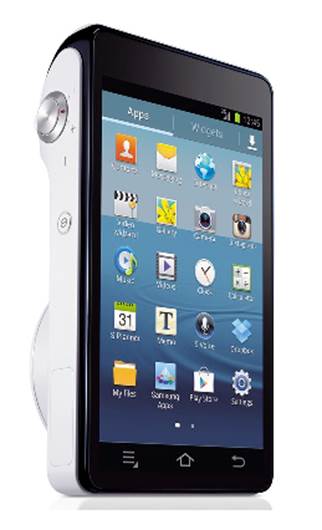Samsung’s “Connected Camera” could
well be the future of digital photography
There’s no denying that smartphones are
becoming the take-everywhere camera of choice for many photographers, although
while the imaging capabilities have improved in recent years, there are still
limitations. The need for a slim and pocketable device means that none have as
yet featured an optical zoom, while sensor size is also limited for the same
reasons. This disparity between smartphone and full-blooded digital camera has
created a gap in the market for a marriage between the two, and into this gap arrives
the Samsung Galaxy Camera.
Features
Dubbed the '“Connected Camera”, the Samsung
Galaxy Camera boasts the bare bones to rival many a conventional digital
camera. At the core of the model sits a back side illuminated l/2.3in CMOS
sensor, the same found in standard compact cameras and larger than that found
in a smartphone. The sensor offers full HD video capture at 1080p and 30fps
alongside traditional stills capture. The Galaxy Camera also packs quite the
optical punch. It features a 21x optical zoom lens that covers a focal range of
23-483mm in 35mm equivalent terms and has a maximum aperture off/2.8 at the
zoom’s wide angle. The lens is also supported by optical image stabilization
technology.

This
composite of two separate images illustrates the struggles of the Galaxy
Camera’s Auto White Balance setting.
The Samsung Galaxy Camera is, in many ways,
the epitome of convergence technology. In no area is this more apparent than on
the rear of the camera, where the largest and most highly specified screen ever
found on a digital camera resides.
The screen measures 4.8in and features a
resolution of 1280 x 720 pixels, thus gaining the HD moniker from Samsung,
while it also benefits from full capacitive touchscreen technology. The screen
features a 16:9 aspect ratio that’s perfect for HD video capture and review.
The model also benefits from integrated
dual-band Wi-Fi technology, although that's just the start of its connected
capabilities, as the Galaxy Camera is the first digital camera to feature
integrated 3G technology and offer cellular network connectivity.
Samsung is keen to push the serious photo
capabilities of the Galaxy Camera, and as a result it features full PASM
exposure modes for image capture. Alongside this advanced functionality are the
traditional shooting modes to make life easier for the relative novice. This
includes the default Auto settings, as well as a range of Smart settings
including Action Freeze and Rich Tone.

The
range of "Smart” modes include a Night composite setting for low light as
used
Design
As you would expect for a model that
possesses the largest screen ever seen on a digital camera, the Galaxy Camera
is by no means small. The rear of the camera is dominated by the touchscreen
with physical buttons noticeable by their absence. While there’s no denying the
benefits of having a 21x optical zoom when it comes to imaging prowess, its
presence in combination with this large touchscreen does turn the Galaxy Camera
into a bulky shooter.

It
does present a bit of an issue when using the Galaxy Camera in traditional
portrait smartphone orientation though, as it’s difficult to get a steady grip
on the camera.
Although the majority of the camera's
functionality is accessed and controlled from the ample touchscreen, the body
does feature a few control buttons. On the top plate sits a shutter release
button complete with zoom lever, as well as a power button.
The only other physical button found on the
camera is the one used to trigger the camera’s flash on the left hand side.
Outside of this, the rest of the body is noticeably minimalist and as a result
it does have a sleek appearance. One possible oversight in the pursuit of
keeping the body as clean as possible is the absence of any functionality
around the lens ring. Samsung’s NX CSC cameras feature an i-Fn function ring
essentially a customizable control wheel - around the lens and thus made better
use of the area. We hope that future Galaxy Cameras will feature the same
functionality.
The right hand side of the Galaxy Camera's
body houses a reasonably-sized handgrip which, in combination with the
protruding lens, offers a steady grip that’s welcome when shooting at longer
focal ranges. It does present a bit of an issue when using the Galaxy Camera in
traditional portrait smartphone orientation though, as it’s difficult to get a
steady grip on the camera.